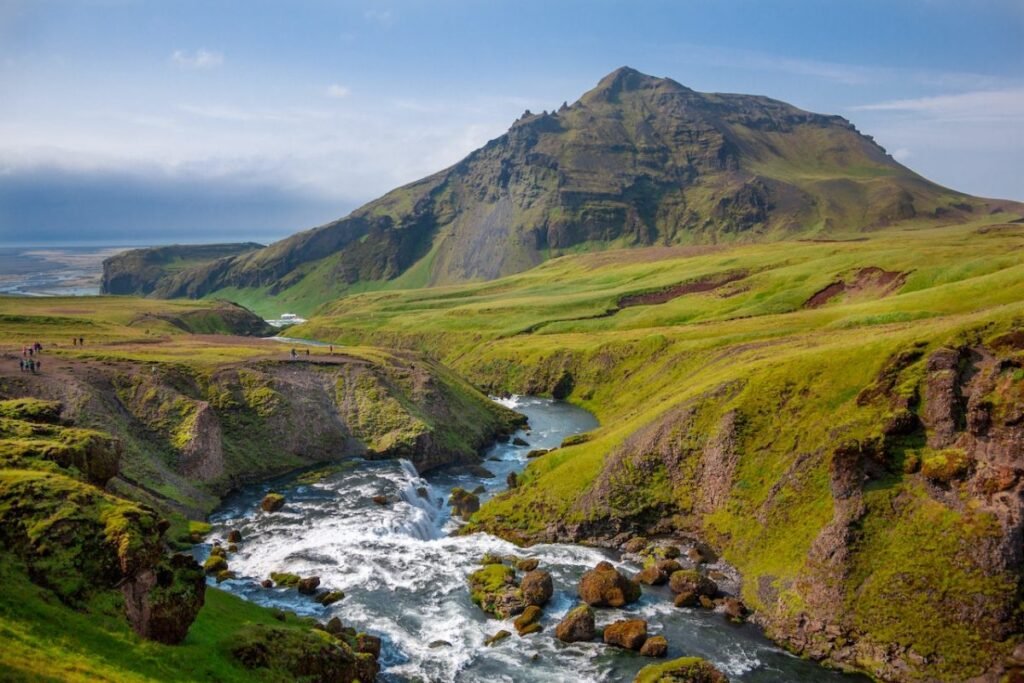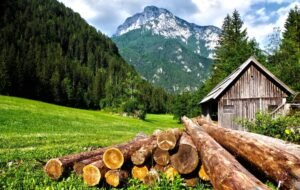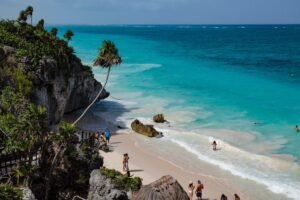
Iceland, often called the land of fire and ice, is a place where nature has shaped a stunning landscape filled with contrasts and breathtaking beauty. From roaring waterfalls to tranquil lagoons, eruptions from volcanoes to massive glaciers, this Nordic island is a fantastic showcase of natural wonders.
For those who love adventure or desire serene vistas, Iceland presents a variety of awe-inspiring sights. Here, we delve into nine of the most remarkable natural features in Iceland, each providing a window into the raw power and beauty of our planet.
Exploring the Blue Lagoon: A Tour Highlight in Iceland
No trip to Iceland is truly complete without experiencing the famous Blue Lagoon. Tucked away in a lava field, this geothermal spa is celebrated for its milky blue water, rich in minerals like silica and sulfur. Known for its restorative properties, the Blue Lagoon serves as both a natural marvel and a luxurious escape.
The warm waters, contrasted by rugged lava formations and the brisk Icelandic air, create an unforgettable experience frequently included in various Iceland tour packages. The Blue Lagoon was accidentally created in 1976 near the Svartsengi geothermal power station, featuring a unique milky cyan color due to the mineral-rich seawater. Its closeness to Keflavik Airport makes it a perfect starting or concluding point for travelers.
Gullfoss: The Golden Falls
Gullfoss, or the Golden Waterfall, stands as one of Iceland’s most iconic and cherished natural wonders. Located in the canyon of the Hvítá River in the southwestern region, this magnificent waterfall is part of the renowned Golden Circle tourist route. Gullfoss captivates visitors with its vast scale and beauty, showcasing two distinct drops that together plunge 32 meters (105 feet)—the first drop measuring 11 meters (36 feet) and the second 21 meters (69 feet).
The waterfall earns its name, meaning “Golden Falls,” from the golden sheen that often cloaks its waters on sunny days, particularly when rainbows arc above. Gullfoss holds cultural and historical significance in Icelandic heritage. It was almost transformed into a hydroelectric power source in the early 20th century, but was ultimately preserved through the relentless advocacy of Sigríður Tómasdóttir, who fought diligently to save it.
The Great Geysir: A Geothermal Wonder
The Great Geysir is one of Iceland’s most famous natural attractions, often featured in tours of the Golden Circle. Situated in the Haukadalur Valley, this geyser is renowned for its impressive eruptions of boiling water that can reach heights of up to 70 meters, though such eruptions have become increasingly rare.
Surrounding the Great Geysir is a geothermally active region filled with smaller geysers, including Strokkur, which erupts more regularly, delighting visitors with displays every few minutes. This geyser has a storied past, with the first mention of it appearing in written records as early as the 13th century, drawing attention to Iceland’s unique geological phenomena.
The word “geyser,” commonly used worldwide to describe hot springs that spout water, has its origins in this Icelandic wonder. The Great Geysir and its surroundings are key components of the Golden Circle, a popular route showcasing Iceland’s most stunning natural sights.
The Northern Lights: A Spectacular Phenomenon
The Northern Lights, also known as the Aurora Borealis, are a breathtaking natural occurrence marked by vibrant light displays in the night sky, primarily visible in high-latitude regions around the Arctic and Antarctic. These mesmerizing lights are generated by the collision of electrically charged particles from the sun with the Earth’s atmosphere. Solar winds carry these particles toward the poles, where they interact with atmospheric gases like oxygen and nitrogen, producing extraordinary light shows.
The colors of the aurora can vary based on the gases involved: oxygen can create green or red hues, while nitrogen often results in blue or purple shades. The display’s intensity is influenced by solar activity and the Earth’s magnetic field.
Best enjoyed under dark, clear skies, the Northern Lights are a significant draw for tourists in countries such as Norway, Iceland, Canada, and Finland.
Jökulsárlón Glacier Lagoon: A Stunning Encounter
Jökulsárlón Glacier Lagoon, situated at the perimeter of Vatnajökull National Park, is a breathtaking natural marvel known for its striking beauty and distinct features. Formed due to the melting of glaciers, it is Iceland’s deepest lake, reaching depths of over 200 meters. The lagoon’s most notable aspect is the large icebergs that break off from the Breiðamerkurjökull Glacier, part of the greater Vatnajökull Glacier. These icebergs, which can appear in shades of blue, white, or even transparent, float serenely in the lagoon, creating a constantly evolving and surreal landscape.
The lagoon is also a sanctuary for wildlife, including seals and numerous bird species, making it a paradise for nature lovers and photographers. Its popularity has surged thanks to its appearances in films and television. Visitors can take boat tours to explore the lagoon up close and personal.
Vatnajökull Glacier: The Largest Glacier in Europe
VATNAJÖKULL glacier, located in Iceland, is recognized as Europe’s largest glacier and a significant natural spectacle. Spanning approximately 8,100 square kilometers, it constitutes about 8% of Iceland’s land area. This immense ice cap is famous for its stunning beauty and varied landscapes, showcasing a blend of ice caves, volcanoes, and subglacial lakes.
Vatnajökull is part of the larger Vatnajökull National Park, a UNESCO World Heritage site known for its unique geological aspects and notable volcanic activity. Beneath the glacier lie several volcanoes, including Bárðarbunga and Grímsvötn, which have historically been active, adding to the glacier’s dynamic character. Its thickness varies, reaching up to 1,000 meters in certain regions. The glacier serves as a critical site for scientific study, offering insights into the effects of climate change and glaciology.
Thingvellir National Park: A Geological and Cultural Gem
Thingvellir National Park, recognized as a UNESCO World Heritage Site, is both a geological and historical marvel celebrated for its exceptional beauty and importance. It features a visible section of the Mid-Atlantic Ridge, where the North American and Eurasian tectonic plates interact and drift apart, resulting in striking landscapes like deep fissures and rugged cliffs. This rift valley provides a rare opportunity to stand between two continental plates.
Historically, Thingvellir is honored as the cradle of Icelandic democracy. Established around 930 AD, the Alþingi is one of the oldest parliamentary institutions globally, holding sessions here for centuries and significantly influencing the nation’s early political and social development. This open-air assembly showcases Iceland’s rich cultural legacy and its journey toward nationhood.
Dynjandi Waterfalls: A Majestic Cascade
The Dynjandi Waterfalls, located in the Westfjords of Iceland, represent a stunning natural wonder and a prime example of the country’s impressive landscapes. Also known as Fjallfoss, translating to “mountain falls,” Dynjandi is the largest waterfall in the Westfjords, soaring to an impressive height of around 100 meters (328 feet).
Unique in its shape, Dynjandi resembles a wide, flowing veil or a bridal train. It starts off narrow at the top and gradually broadens as it cascades over a series of rocky terraces, creating a spectacular visual effect.
The surrounding area is equally captivating, showcasing the lush greenery and rugged terrain typical of Icelandic scenery. Dynjandi is easily accessible to tourists, with a well-maintained hiking trail leading to the waterfall, allowing visitors to experience its beauty up close.
The Black Sand Beaches of Vik
The Black Sand Beaches of Vík, particularly Reynisfjara, are famous for their striking and distinctive landscapes. Positioned near the town of Vík í Mýrdal on Iceland’s South Coast, these beaches are characterized by their unique jet-black volcanic sand.
Reynisfjara Beach is the most famous of these, known for its dramatic basalt columns, towering boulders reaching heights of 68 meters, and picturesque coastal views. The beach is a favored destination included in many South Coast Tours and road trips across Iceland.
The black sand found on these beaches originates from volcanic lava rock erosion. The unique appearance and geological features of these beaches create a significant tourist attraction. However, visitors are cautioned to keep a safe distance of about 30 meters from the wave’s edge due to the unpredictability and potential dangers of the sea.
Conclusion: Exploring Iceland’s Natural Marvels
Iceland’s natural wonders provide an unmatched experience for travelers. From unwinding in geothermal spas to hiking across glaciers, witnessing the Northern Lights to exploring geysers and waterfalls, Iceland is a destination that elevates the extraordinary.
Each of these nine wonders reveals a unique aspect of Iceland’s diverse and enchanting landscape. For those seeking an unforgettable adventure, the natural marvels of Iceland await, promising memories that will last a lifetime.






